The territory of Iglesias, its mines and its extraordinary historical and cultural heritage is a landscape perfectly suited to tourism, not mass tourism but tourism able to bring about lasting changes to produce economic answers capable of recreating permanent identities in a new landscape.
The development of a territory is complex and difficult to understand in its political, institutional, administrative and especially economic relations, where various participants compete for management roles and make decisions on rules and regulations to transform areas by planning processes of varying complexity. Traditional planning processes carefully analyse the area, describe all its aspects, divide it according to typology and categorise it into different groups. This increasingly evolved and refined division forms the basis of subsequent “predictions” which often lack long-term vision as an objective: they do not appear to provide adequate “images” of future scenarios.
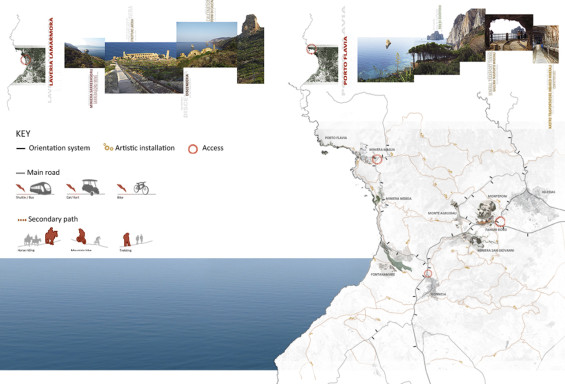
This idea of research claims to establish a process of poetic identity, a tendency towards knowledge in its entirety, without the need to divide parts into individual pieces. A process of poetic identity which clearly coincides with the images produced, stating that these are the fundamental system of acknowledging identity.
This concept was better expressed by the garden historian J.D. Hunt who wrote, “with poetry I don’t mean lines, a studied organization of rhymes and rhythms which would require the readers a sudden , different and even ”unrealistic” capability of things. Instead with poetry I intend a higher version of the world, an extension of our usual reactions to go beyond the real conditions, without necessarily having to exclude them. The poetry can bring us out of ourselves giving us back our usual lives, maybe changed and fuller, at least a bit disturbed and different, however without being forced to use daily rhymes and rhythms”.
This definition is the basis upon which the perception of identity is founded, with the knowledge that a territory, a space, and therefore a place, should not only be studied scientifically by means of conventional systems and codes of research: a list (obviously essential in the most evolved processes of a project) of the intrinsic qualities of every element that constitutes the site.
What we are trying to examine is an “extended artistic” and therefore “poetic” essence of this site in search of the relationship between different objects that Calvino fully expressed in one of his most beautiful but lesser known stories “Dall’Opaco”; space is no longer limited to three Cartesian axes but are multiplied in a specific man-made vision and the position it adopts within its context. It is that condition towards “marginality” (not intended as a distant place, but margin in the sense of communication, reciprocity) that allows all the elements of a site to stay together, to dialogue and to form those specific formal, aesthetic, functional and economic conditions that make a site the expression of a man’s identity.
The poetic condition of being in a place is therefore the main condition to reorder a process of intervention and transformation. The process of landscape goes beyond the concept of perspective linked to architecture, or the concept of planning regulation, is the method used to render visible (images) the poetic aims over time.
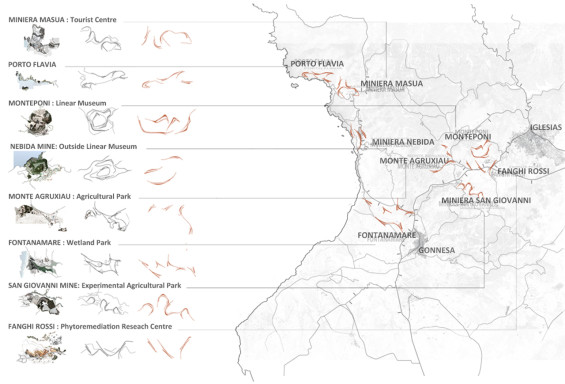
In landscape processes time is an essential variable: if in architecture, or in planning generally, time is immobilised, the concept of landscape instead presumes a continuous transformation of perceived space, both in the small scale of the seasons (years) and also in the large scale of time (decades); the landscape forces its space to continuously modify itself.
This changing process of the landscape is innate in its becoming and in its shaping, it is perfectly inherent to a system of spaces in search of identity. The mines and territory of the Iglesiente district, historically an area of continual change, where stasis has never had value, are suited to the complex process of the landscape.
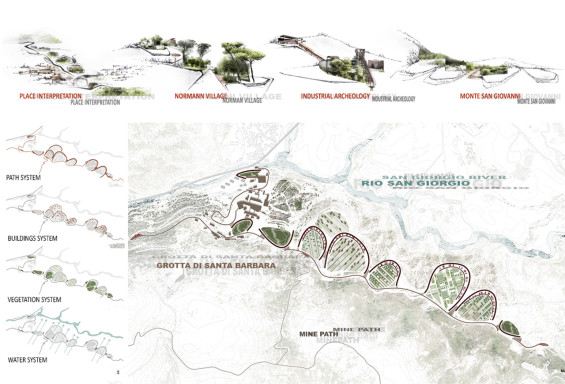
This site, due to economic needs in particular, was subjected to continual change over the years by excavation techniques which have improved over time and modified its meanings and values. The strange process of “writing” carried out with the excavation of the mines (the sections and plans of the mountain interior are the riches of an ancient and potent poetry, written using a popular alphabet) and with the morphology of the territory modified (extensive writing of marginal spaces dominated by a simple story), reached a point in which the unsustainability of the economic process suddenly immobilised the landscape of the mines.
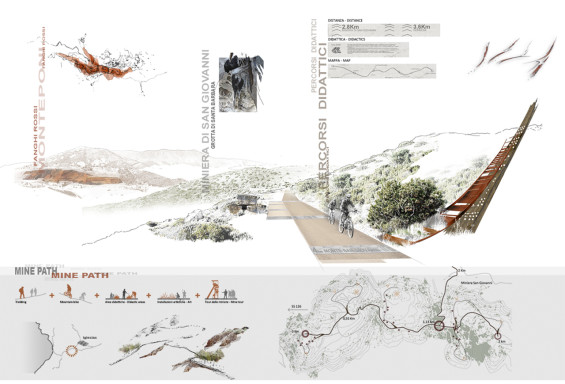
In the meantime the landscape seems to be waiting for itself; nature pushes to re-colonise the abandoned industrial spaces while man is undecided, recognising and admiring the beauty of the transformation. An admiration of stasis caused by the strange nostalgic feeling towards “industrial ruins”, or the disconcerting perception of the interpretation of the schedule of the new morphologies of “rejected” lands.
The landscape of the Iglesiente territory comprises two fundamental poetic concepts; a more evident natural-artificial relationship and a less overt internal-external relationship. The former focuses on defining the scope of its affinity with strength and immediacy: nature on one hand and artificiality on the other. The second concept is more implicit and is based on the duality between interior and exterior, evident from the planimetry or sections of mountains and their tunnels (complex popular “writings”); outside this is expressed in points that are ruins of the mining industry, or for spaces which are morphologies modified by the accumulation of excavation mud.
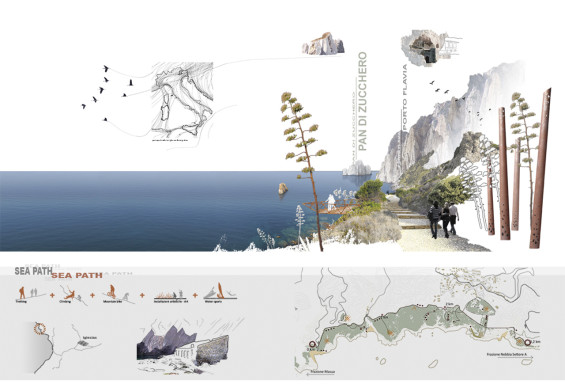
With regard to this duality that exists in the Iglesiente territory, an attempt has been made to create a development model of the territory based on a system of actions and reactions. Art created according to landscape sculptures informs the duality between interior and exterior by means of landmarks on the territory or describes the characteristics of the places locating its sculptures, created also with the help of tourists.
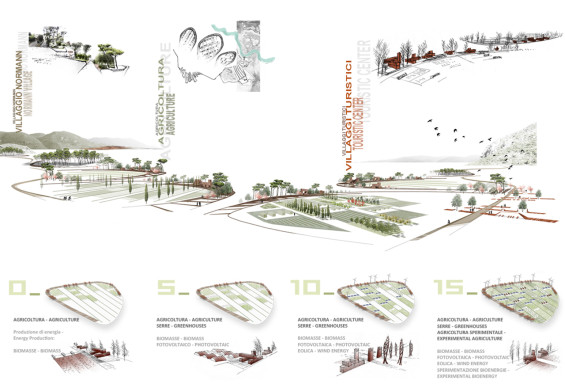
Agriculture makes the transformation of the territory real defining it by relationships that are also closely linked to tourism. The dynamism of the landscape develops into landscape economies, a development over time able to become self-sufficient in a continual and complex system of exchanges and perspectives.
Starting from the concept that the landscape is made by economies (every landscape has its own economy; when the economy changes the landscape also changes), tourism-based economies created to belong to the local area (tourism that leaves its traces by actively collaborating in modifying an area) form the basis of the economic process of the poetic landscape of the Iglesiente area, organised with a strategy divided into three parts.
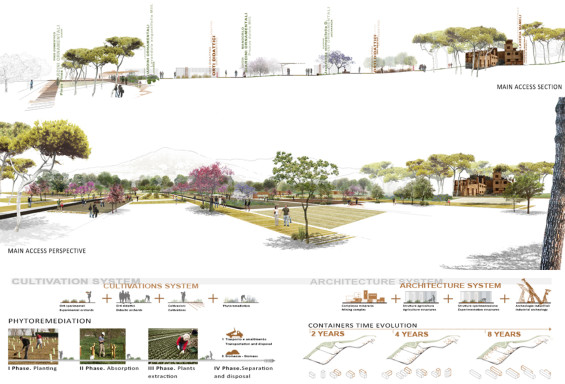
The first part, on the large scale of the landscape, designs a “morphological grammar”, an analysis of the territory and forms a substantial basis for each process of change.
The second part, on the medium scale, organises the paths enabling them to develop new communications through art. Finally, the third part, on the small scale, plans the sites of the mines by identifying specific functions, services and activities for tourism, energy and agriculture. The three landscape scales are not linked in any specific way to the numeric scale of the territory, but rather refer to the scale of ideas: morphological grammar, belonging, detail and function. With reference to the large scale of morphological grammar, all interventions can be skillfully allocated according to well-defined identities within the territory. A final analysis of the poetical interpretation of the morphology of the Iglesiente area builds the relationship between spaces and objects within the landscape, indicating the overlapping over time of points of interest to mark their belonging. It is not a credible action plan in its general hypothesis, but a process of identity that, being a process, has all the possible inconsistencies which make it feasible.
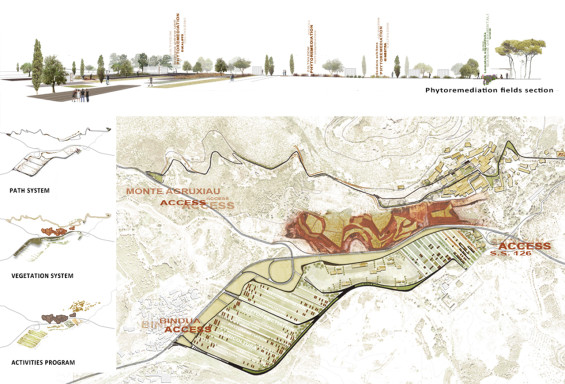
Landscape Process. Tourism of identity for the Mines of Iglesiente
The names of the designers | Prof. Arch. Valerio Alberto Morabito
Location | Iglesiente, Sardinia, Italy
Image Credits | APS Spin-off UNIRC

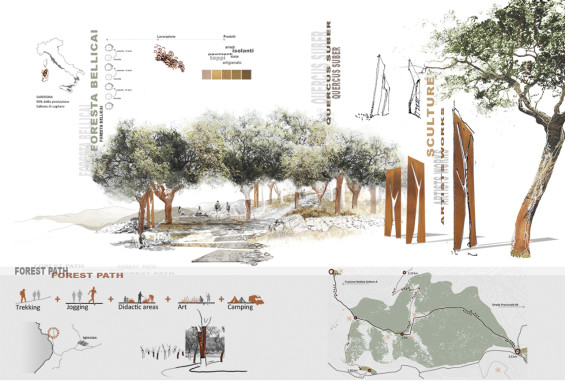
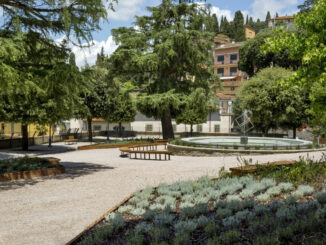
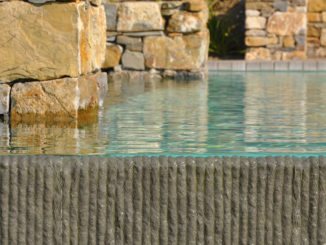
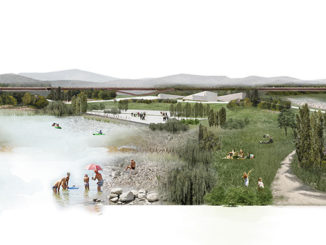
Pity about the poetic language that goes nowhere towards describing process and practical outcome. This is a beautiful part of the world punctuated by mining ‘follies’ – a little more graphics of what is proposed and/or outcomes might shine some light on the project for the mere earthbound.